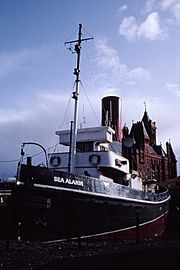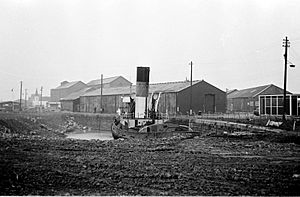ST Sea Alarm facts for kids
class="infobox " style="float: right; clear: right; width: 315px; border-spacing: 2px; text-align: left; font-size: 90%;"
| colspan="2" style="text-align: center; font-size: 90%; line-height: 1.5em;" | 
|} The ST Sea Alarm was a special kind of boat called a tug. Tugs are powerful boats that push or pull other ships, especially big ones, in and out of harbours or through narrow waterways. This tug weighed 263 tons.
It was first built in 1941 and named Empire Ash. It was made for the Ministry of War Transport, which was a government group in the UK that managed ships during World War II. After the war, in 1947, the tug was sold and its name changed to Flying Fulmar. Then, in 1956, it was sold again and got its final name, Sea Alarm.
When Sea Alarm stopped working as a tug in 1973, it became a display at the Welsh Industrial and Maritime Museum in Cardiff. This meant people could visit and learn about it. However, in 1998, the museum had to close. Sadly, Sea Alarm was then taken apart for scrap, which means its parts were recycled. This decision caused some public discussion and upset at the time.
Contents
| History | |
|---|---|
| Name |
|
| Owner |
|
| Port of registry | |
| Builder | John Crown & Sons Ltd, Sunderland |
| Yard number | 201 |
| Launched | 13 August 1941 |
| Completed | 17 October 1941 |
| Identification | |
| Fate | Scrapped 1998 |
| General characteristics | |
| Tonnage | 263 GRT |
| Length | 107 ft 8 in (32.82 m) |
| Beam | 26 ft 2 in (7.98 m) |
| Draught | 12 ft 5 in (3.78 m) |
| Propulsion | 1 x triple expansion steam engine (Swan, Hunter & Wigham Richardson Ltd, Newcastle upon Tyne) 102 hp (76 kW) |
The Life of a Tugboat: From War to Museum
The Empire Ash was built by a company called John Crown & Sons Ltd in Sunderland, England. It was launched into the water on August 13, 1941, and finished being built on October 17, 1941. It was made to help with the war effort for the Ministry of War Transport.
Changing Owners and Names
On May 15, 1946, the Empire Ash was sold for £18,750 to a company called Clyde Shipping Co Ltd in Glasgow. They renamed it Flying Fulmar.
In May 1956, the tug was sold again to C J King & Sons in Bristol and renamed Sea Alarm. It was managed by a company called Alarm Steam Tug Co Ltd.
Becoming a Museum Exhibit
In January 1973, Sea Alarm was sold to a company that usually scraps old ships. However, the very next month, it was bought by the Welsh Industrial and Maritime Museum in Cardiff.
The museum worked to fix up the tugboat, and by 1978, it was fully restored. For many years, it was kept in a special dry dock at Roath Dock, where visitors could see it.
The End of the Sea Alarm
The museum where Sea Alarm was displayed closed its doors on June 1, 1998. After the closure, the Sea Alarm was taken apart for scrap, except for its engine. This decision caused some public concern, and even government officials in the Select Committee on Welsh Affairs asked questions about why the tug was scrapped.
How Ships Are Identified: Numbers and Codes
Just like people have identification numbers, ships have them too!
Official Numbers and Code Letters
When it was first built, Empire Ash had a UK Official Number, which was 168694. It also used special Code Letters called BCRK. These numbers and letters helped identify the ship. Official Numbers were used before the modern IMO Numbers were created.
IMO Number
Later, the Sea Alarm was given an IMO number, which is 5315943. An IMO number is a unique identification number given to ships to help track them around the world.


